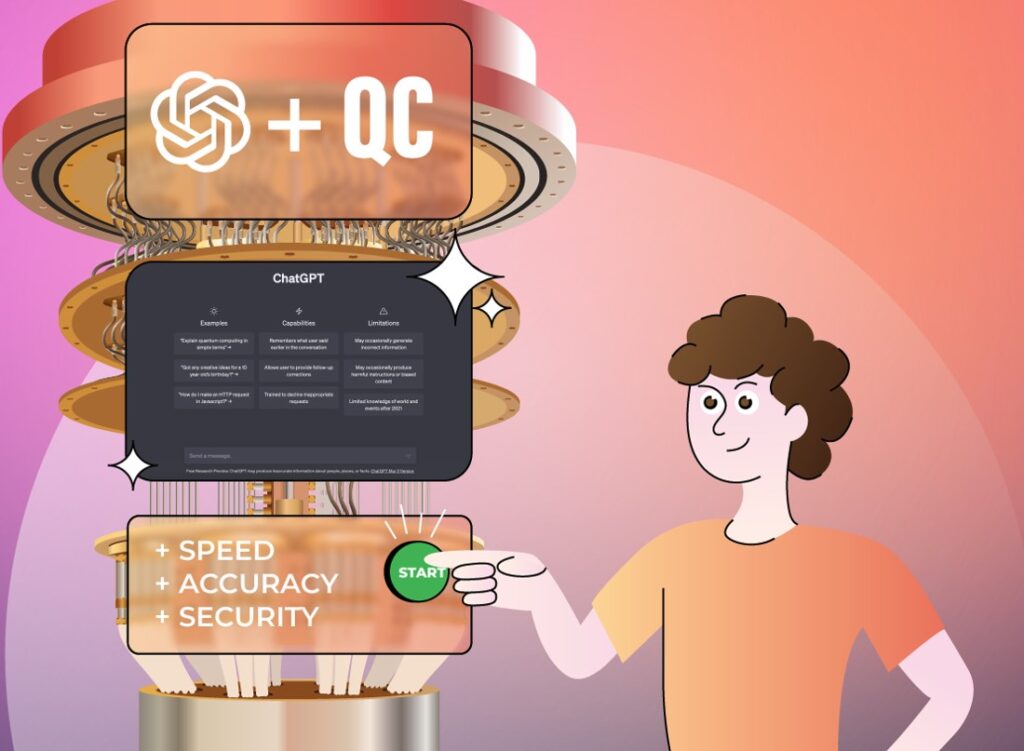Table of Contents
November 30th, 2022 will remain evergreen in the tech world. As you know, American artificial intelligence (AI) research lab OpenAI launched the generative artificial intelligence chatbot, ChatGPT, on the said date. ChatGPT means Chat Generative Pre-trained Transformer, an autoregressive language model that leverages deep learning to output human-like replies.

Basically, ChatGPT is an AI-powered natural language processing tool that supports and simulates a human-like conversation (chatbot). It uses OpenAI’s large language models (LLMs), the language processing techniques that enable computers to grasp chats and generate logical replies. Indeed, the AI chatbot took the world by storm as everyday people and businesses use it to tackle their real-world problems.
It makes perfect business sense because the generative AI program gives you sensible and logical answers to questions; it also helps you with other tasks such as simulations, coding, generating images, videos, and audio, writing articles and emails, etc.
Five days after its release, OpenAI chief executive officer Sam Altman disclosed that the AI tool already had over one million users worldwide.
In summary, in a customer service environment, you can use ChatGPT to:
- Engage customers in multiple languages
- Analyze sentiments
- Monitor customer data and satisfy a customer
- Give personalized responses
- Give prompt responses to customers’ inquiries and complaints
- Create tailored email templates (reaching new customers)
- Reply customer review
- Perform multiple tasks
- Answer frequently asked questions (FAQs)
- Stay in touch with your customers 24/7.
All these are the benefits of using the AI chatbot to manage the customer service ecosystem of a typical e-commerce business. Little wonder tech pundits forecast it will leave many people jobless in the coming years. As ChatGPT leaves indelible imprints, one wonders how quantum computing (QC) – that’s much faster than classical computers – will impact the AI program. Before we jump into that detail and find out How Will Quantum Computing Impact ChatGPT, let’s briefly explain how developers train AI chatbots.
How ChatGPT Works (A Simple Analogy)
If you want to better understand the wizardry behind ChatGPT, you have to grasp what generative AI is. Now, let’s draw a simple analogy. Think of generative AI as a new-born baby who doesn’t know how to speak, write, and read yet. As the baby grows, he listens to his father and mother converse at home. Aside from his parents, his siblings, uncles, aunties, grandma, grandpa, and everyone around him speak to him, and he learns. They also teach him the do’s and don’ts of the contemporary society.

These people are already training this kid. In artificial intelligence, this is called unstructured learning. Yes, the baby is learning, but nobody defines this learning process. Now, compare this type of learning with when he (the baby) enrolls in school much later in life. Here, the tutor instructs him in specific ways that the school or tutor grades. Yes, you are right – this second type of learning is known as structured learning.
Remember, before the baby started schooling, the chances are that he could speak. He knows how to make sentences and spell words correctly and incorrectly. He learned all this from home. However, when his parents register him in a school, he begins to validate what he already knows.
The only difference between unstructured learning and structured learning is that unlike the former, the latter is definite and organized. Besides, his tutor grades his performance in structured learning, meaning that he could pass or fail his test/examination. The baby stores all this information (knowledge) he has acquired over time in his brain. His brain has neurons (neural networks) that help him test the authenticity of data until he forms an opinion about it. To form an opinion, in this context, means that he has learned, for example, that two (2) plus (+) four (4) is six (6). At this point, the boy will quickly answer six if his teacher asks that question in the class. Well, that’s how ChatGPT learns.
In other words, generative AI allows computers to conceptualize and generate new models or content. Algorithms can also learn or mimic patterns and structures found in existing data distribution. By running on neural networks, it keeps testing inputs until it churns out the correct outputs using a trial-and-error technique. The process takes time and consumes a lot of computational energy.
A generative model is a powerful unsupervised way of learning data distribution. You train a large language model (computational power, data storage, and human resources) in order to create a generative model. Plus, you give the model various examples from a dataset and adjust its parameters to match the data distribution. At this juncture, you can say you have trained the model. Afterward, you can use your findings to generate new data sampling from the learned data distribution. Once you train the neural network, its classifier can predict images or output information with 98% confidence.
4 Ways Quantum Computing Will Impact ChatGPT
Now, it is safe to say that you understand how the Generative AI models work (the foundational technology of ChatGPT). Now, let’s closely examine how will Quantum Computing impact ChatGPT in the future.
1. Improved Accuracy
As you already know, OpenAI built ChatGPT using the generative AI model. Now, one of the challenges of Generative AI is the amount of data required to train the models. In other words, the larger the amount of data, the better models. The bigger the amount of data, the harder it becomes to train the neural network. The AI technique enables computers to understand the real world. Over the years, there has been tremendous progress in that space, but industry experts still have a lot to do. Because of the challenge of training a large amount of data in Generative AI, this is where quantum computing comes in. Since quantum computing can process a large amount of data and tackle computational puzzles at the speed of light, it will play a significant role in the development of ChatGPT.

Admittedly, the ChatGPT team has done an excellent job in developing a generative AI chatbot. However, the AI chatbot still has limited knowledge – something its global users hope to see the later versions correct. Consequently, many critics have claimed that the chatbot is biased – a word that is almost nonexistent in computer technology as tech promotes transparency and objectivity. When QC companies fully develop and commercialize QC systems, quantum AI systems can generate more accurate and complex outputs. That’s simply because the QC systems run much faster than conventional computers. Therefore, training the neural network won’t be as hard as it is with today’s classical computers. Remember, the bigger the data, the more accurate the AI tool becomes. In a nutshell, quantum computing will improve the accuracy of ChatGPT.
2. Lowering Trick Chances
As you have learned, populating the neural network with data and training the model takes time. According to findings, it took OpenAI about 18 months to build ChatGPT’s neural network and train the model. It is somewhat due to its multistage process of training the model in a massive amount of text data using deep learning techniques.
Even though the OpenAI team appears to have reached their finish line, they are obviously getting started. The reason is that they keep updating the AI tool so that people don’t abuse it. To be more explicit, since its launch in November 2022, the developers have noticed a trend among some mischief makers who are increasingly trying to trick ChatGPT to make mistakes. It is known as adversarial examples in deep learning.
More often than not, these cyber-attackers try to input inaccurate information into its neural network so that ChatGPT can give wrong answers. They often target the algorithm to hack the network. If they succeed, it makes nonsense of the entire buzz around the chatbot. Because of differentiability, once these attackers hack into the neural networks and apply imperceptible modifications to the input, it alters the output of the AI program.
To avert that, the developers have employed adversarial training. Adversarial training means introducing negative instances and models into the network and labeling them as threats. This way, they prevent adversarial machine learning attacks by teaching the AI tool to ignore those attackers. The downside is that it requires a large amount of maintenance.
Because quantum computers will have more tamperproof network security than classical computers, there will be little or no chance of tricking its neural network (Quantum ChatGPT’s network). Developers believe QC systems will have improved information security because qubits leverage unique quantum properties to function (quantum cryptography). Truly, this is another way quantum computing will improve ChatGPT.
3. Reduced Training Time
Since OpenAI launched ChatGPT, many tech analysts have eulogized the chatbot, while critics have raked it over the coals. As for the critics, they compare ChatGPT to human beings, focusing chiefly on its inability to give detailed, satisfactory explanations.

Most times, they fault ChatGPT, saying that it has limited knowledge because it doesn’t have access to a large amount of information like humans. They even consider laughable the idea that ChatGPT will take the place of human roles in companies. Truly, they are not totally wrong because the AI chatbot cannot satisfactorily answer questions about specific niches. In fact, it is not aware of the latest development or changes in some fields. Giving more insights into the debate, a writer published a Medium article faulting ChatGPT’s explanation of quantum computing. In all fairness, the OpenAI team has achieved a feat, but they still have work to do (yes, they know that).
On the flip side, once the chatbot starts running on quantum computers, there will be positive changes because the next-gen computers run much faster than classical computers. Simply put, the training process will be faster on quantum computers than today’s conventional computers due to the former’s fast-processing capabilities. The story that often comes to mind is the claim the Google team made in 2019 when they announced that they have attained quantum supremacy. According to the tech corporation, they used their QC processor, Sycamore, to solve a computational puzzle in minutes that would take today’s fastest computer about 10,000 years to tackle. If the revelation is anything to go by, Quantum ChatGPT will have more data and get its teeming users to trust its answers. That’s because the developers can train its model – which will contain terabytes of data – in no time. They can also update it frequently. This way, it will have more reliable information.
4. Lower Computational and Training Cost
Admittedly, tech enthusiasts are already criticizing ChatGPT, citing its computational cost and power as a big obstacle. Guess what, plans are underway to improve today’s ChatGPT. However, that won’t change the fact that the chatbot is a sophisticated AI language model that requires substantial computational resources to optimally operate it.
In other words, running the model in today’s conventional computers requires access to specialized hardware systems. If you choose to do that on specific low-end systems with limited computational power, it may result in lowered processing time, reduced accuracy, and other issues. Therefore, intended enterprise users must consider this before jumping on the bandwagon.
Likewise, training neural networks requires a lot of energy because researchers depend on massive server farms to provide data for training the powerful program. As a result, cooling the data centres makes the AI chatbots incredibly thirsty. One study disclosed that training GPT-3 alone consumed about 700,000 liters of water.
Now, you may be wondering how possible it is that quantum computers can solve this problem because it also requires a lot of computational power itself. In fact, developers keep quantum processors at a low temperature of about 15 millikelvin (-273oC) to function optimally.
The good thing is, that is one of the reasons why universal gate quantum computers haven’t gone commercial yet. Quantum computer engineers and scientists are still exploring ways of building qubits without expending so much computational energy. In recent times, many early-stage QC startups have joined the race to commercialize the emerging technology. These new kids on the quantum block plan to improve current physical qubits and scale quantum computers using an entirely different approach like fusion-based quantum computing. When this finally happens, it considerably solves the problem of excess energy consumption.
What Does the Future Hold for Quantum ChatGPT?
Let’s be crystal clear here, we don’t intend to join the large contingent of writers criticizing ChatGPT online but to emphasize how quantum technology can enhance it. Try as hard as you can, you cannot deny the indisputable fact that the AI chatbot can solve a bunch of real-world problems. In short, the OpenAI team says they are just getting started.
In other words, like fine wine, ChatGPT will get better with time. In short, the OpenAI team is already working hard to upgrade the most-talked-about chatbot. Sure, the team deserves some commendation for its ability to crack the AI chatbot development puzzle. Despite that, it is misleading to remotely assume that the sensational AI chatbot can take the place of humans; the AI chatbot still requires a lot of improvement.
To recount some of its drawbacks, ChatGPT doesn’t have human-level common sense, and it lacks in-depth emotional intelligence. Still, it doesn’t generate independent and insightful conclusions/thoughts yet, and it has limited understanding of contexts (such as sarcasm and humours). Therefore, you have to fine-tune it to suit your needs whenever you use it.
But then, these limitations exist because its neural network has limited data now. Think of the current ChatGPT as a 5-year-old boy and Quantum ChatGPT as a 40-year-old man. You can say that ChatGPT is still learning. When the QC machine goes commercial, Quantum ChatGPT will become the in-thing and run without the current limitations. Then, it will process lots of information in no time, meaning that QC technology will improve the AI chatbot in many profound ways in the future. So, wait for it!
About the author: Ashwin Saxena
Founder, of Cybranex Technologies and consultancy pvt ltd, is a physicist with a strong background in deep theoretical physics and a passion for scientific understanding.
Ashwin had the vision to pursue a PhD in an application-oriented branch of physics-oriented towards societal growth, and while working towards this goal, developed an interest in interdisciplinary research and development infrastructure. As he neared the end of his PhD, he decided to put his vision into action by starting a company in the relevant technological domain.

